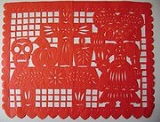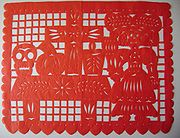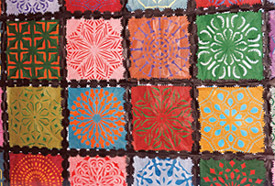
Papel picado
Encyclopedia
Papel picado is a decorative craft made out of paper cut
into elaborate designs. Although it is a Mexican folk art
, papel picado is used as a holiday decoration in many countries. The designs are commonly cut from tissue paper
using a guide and small chisel
s, creating as many as forty banners at a time.
Papel picado can also be made by folding tissue paper and using small, sharp scissors. Common themes includes birds, floral designs, and skeletons. They are commonly displayed for both secular and religious occasions, such as Easter, Christmas, the Day of the Dead
, as well as during weddings, quinceañera
s, baptisms, and christenings. In Mexico, papel picado is especially incorporated into altars during the Day of the Dead!
During the Aztec
times, Aztecs used mulbery and fig tree barks to make a rough paper called "Amatl
". When tissue paper became available, artisans usually layer 40 to 50 layers of tissue and punch designs into them using "fierritos", a type of chisel. Paper Piscados are hung with strings and are called "banderitas".
 San Salvador Huixcolotla is a municipality in the Mexican state of Puebla
San Salvador Huixcolotla is a municipality in the Mexican state of Puebla
and is considered the center of papel picado. It is known for having a large community of craftsman who produce high quality papel picado.
In Huixcolotla, papel picado is primarily produced for the celebrations surrounding the Day of the Dead. Over time, the tool used to make papel picado has changed from scissors to chisels because of the greater precision and detailing they allow. Traditionally, the art of making papel picado has been passed from generation to generation. Around 1930, the art spread from Huixcolota to other parts of Mexico such as Puebla and Tlaxcala. Sometime in the 1960's, papel picado spread to Mexico City
and from there to the United States
and Europe
.
The first step is to draw out the design on paper and then cover the paper with transparent plastic. This will protect the original drawing. In order to produce multiple copies at once, fifty to one hundred sheets of China paper are stacked and then stapled together. Using multiple chisels with differently shaped tips, the artist cuts out pieces of the paper from the stack. This allows the carving of many copies of a design at one time.
The stack is then separated, with each sheet of paper being a papel picado. Each sheet is identical to all the others in the stack.
 Sky blue or pink and white are commonly chosen for celebrations in honor of the Virgin Mary, yellow and white for parton saints, vibrant pink, orange, and purple are the key tones employed for ofrendas (offerings) associated with the Day of the Dead (El Dia de los Muertos). Shades of purple are also widely used at Easter. The colors of the Mexican flag--red white and green-- are set aside for venerating the nation's patroness, La Virgen de Guadalupe, as well as for commemorating Independence Day, Sept. 16th. Rainbow hues are appropriate for Christmas and non religious festivities.
Sky blue or pink and white are commonly chosen for celebrations in honor of the Virgin Mary, yellow and white for parton saints, vibrant pink, orange, and purple are the key tones employed for ofrendas (offerings) associated with the Day of the Dead (El Dia de los Muertos). Shades of purple are also widely used at Easter. The colors of the Mexican flag--red white and green-- are set aside for venerating the nation's patroness, La Virgen de Guadalupe, as well as for commemorating Independence Day, Sept. 16th. Rainbow hues are appropriate for Christmas and non religious festivities.
Papercutting
Papercutting is the art of cutting paper designs. The art has evolved uniquely all over the world to adopt to different cultural styles.-History:...
into elaborate designs. Although it is a Mexican folk art
Mexican handcrafts and folk art
Mexican handcrafts and folk art is a complex collection of items made with various materials and intended for utilitarian, decorative or other purposes. Some of the items produced by hand in this country include ceramics, wall hangings, vases, furniture, textiles and much more...
, papel picado is used as a holiday decoration in many countries. The designs are commonly cut from tissue paper
Tissue paper
Tissue paper is a lightweight paper or, light crêpe paper. Tissue can be made both from virgin and recycled paper pulp.-Properties:Key properties are: strength, absorbency, basis weight, thickness , brightness, stretch, appearance and comfort....
using a guide and small chisel
Chisel
A chisel is a tool with a characteristically shaped cutting edge of blade on its end, for carving or cutting a hard material such as wood, stone, or metal. The handle and blade of some types of chisel are made of metal or wood with a sharp edge in it.In use, the chisel is forced into the material...
s, creating as many as forty banners at a time.
Papel picado can also be made by folding tissue paper and using small, sharp scissors. Common themes includes birds, floral designs, and skeletons. They are commonly displayed for both secular and religious occasions, such as Easter, Christmas, the Day of the Dead
Day of the Dead
Day of the Dead is a Mexican holiday celebrated throughout Mexico and around the world in many cultures. The holiday focuses on gatherings of family and friends to pray for and remember friends and family members who have died. It is particularly celebrated in Mexico, where it attains the quality...
, as well as during weddings, quinceañera
Quinceañera
Quinceañera , sometimes called "Fiesta de quince años", "Fiesta de Quinceañera", "Quince años" or simply "quince", is the celebration of a girl's fifteenth birthday in parts of Latin America and elsewhere in communities of immigrants from Latin America...
s, baptisms, and christenings. In Mexico, papel picado is especially incorporated into altars during the Day of the Dead!
Origins
Papel picado comes from Chinese paper cutting and it was made in Europe during the sixteenth century, although it was called 'papel cortado' (cut paper). The two crafts are not exactly the same, as the European version was cut, while the Mexican form is chiseled. In Mexico, during the middle of the nineteenth century, people were forced to buy products from hacienda stores, where they encountered China paper.During the Aztec
Aztec
The Aztec people were certain ethnic groups of central Mexico, particularly those groups who spoke the Nahuatl language and who dominated large parts of Mesoamerica in the 14th, 15th and 16th centuries, a period referred to as the late post-classic period in Mesoamerican chronology.Aztec is the...
times, Aztecs used mulbery and fig tree barks to make a rough paper called "Amatl
Amatl
Amate is a form of paper that has been manufactured in Mexico since the pre Hispanic times. Amate paper was extensively produced and used for both communication, records and ritual during the Aztec Empire; however, after the Spanish conquest, its production was mostly banned and replaced by...
". When tissue paper became available, artisans usually layer 40 to 50 layers of tissue and punch designs into them using "fierritos", a type of chisel. Paper Piscados are hung with strings and are called "banderitas".
San Salvador Huixcolotla

Puebla
Puebla officially Estado Libre y Soberano de Puebla is one of the 31 states which, with the Federal District, comprise the 32 Federal Entities of Mexico. It is divided in 217 municipalities and its capital city is Puebla....
and is considered the center of papel picado. It is known for having a large community of craftsman who produce high quality papel picado.
In Huixcolotla, papel picado is primarily produced for the celebrations surrounding the Day of the Dead. Over time, the tool used to make papel picado has changed from scissors to chisels because of the greater precision and detailing they allow. Traditionally, the art of making papel picado has been passed from generation to generation. Around 1930, the art spread from Huixcolota to other parts of Mexico such as Puebla and Tlaxcala. Sometime in the 1960's, papel picado spread to Mexico City
Mexico City
Mexico City is the Federal District , capital of Mexico and seat of the federal powers of the Mexican Union. It is a federal entity within Mexico which is not part of any one of the 31 Mexican states but belongs to the federation as a whole...
and from there to the United States
United States
The United States of America is a federal constitutional republic comprising fifty states and a federal district...
and Europe
Europe
Europe is, by convention, one of the world's seven continents. Comprising the westernmost peninsula of Eurasia, Europe is generally 'divided' from Asia to its east by the watershed divides of the Ural and Caucasus Mountains, the Ural River, the Caspian and Black Seas, and the waterways connecting...
.
Production
Traditionally, papel picado is made entirely by hand.The first step is to draw out the design on paper and then cover the paper with transparent plastic. This will protect the original drawing. In order to produce multiple copies at once, fifty to one hundred sheets of China paper are stacked and then stapled together. Using multiple chisels with differently shaped tips, the artist cuts out pieces of the paper from the stack. This allows the carving of many copies of a design at one time.
The stack is then separated, with each sheet of paper being a papel picado. Each sheet is identical to all the others in the stack.
Cultural significance
The Ministry of Tourism and Culture in Mexico officially recognizes and supports the art of papel picado. In 1998, the governor of the state of Puebla decreed that the style of papel picado produced in San Salvador Huixcolota is part of the 'Cultural Heritage of the State of Puebla (Patrimonio Cultural del Estado de Puebla).Coloring

Notable papel picado artists
- Marcelino Bautista SifuentesMarcelino Bautista SifuentesMarcelino Bautista Sifuentes is a Mexican-American artist known for his papel picado . Sifuentes currently resides in Los Angeles, CA. Born in Zacatecas, Mexico, and raised in Los Angeles, California, He began learning his skills later in his adult life...
- Olga Ponce Furginson
- Margaret Sosa
- Josie Alarcon
- Margaret'Quica'Alarcon
- Herminia Albarrán RomeroHerminia Albarrán RomeroHerminia Albarrán Romero is a Mexican-American artist known for her papel picado and altar-making. She received the National Heritage Fellowship award from the National Endowment for the Arts in 2005. Romero currently resides in San Francisco, CA. Born and raised in Tlatlaya, Mexico, Romero began...
- Alberto Torres y Cordero
- Catalina Delgado Trunk

